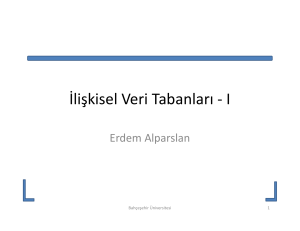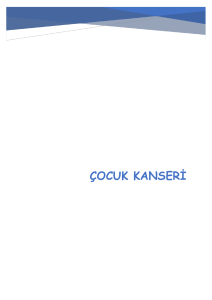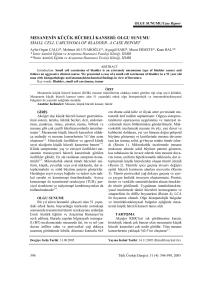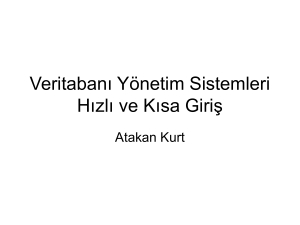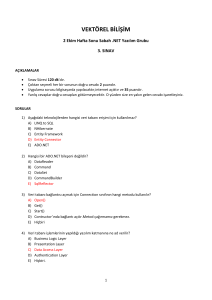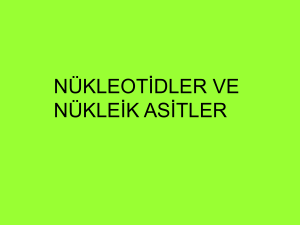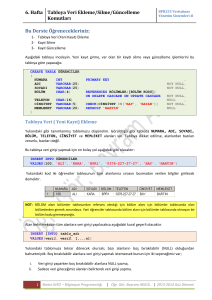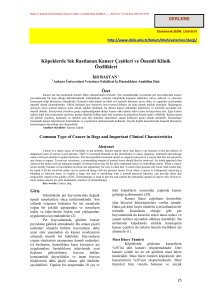genel hayvan besleme soruları.27 haziran 2014
advertisement
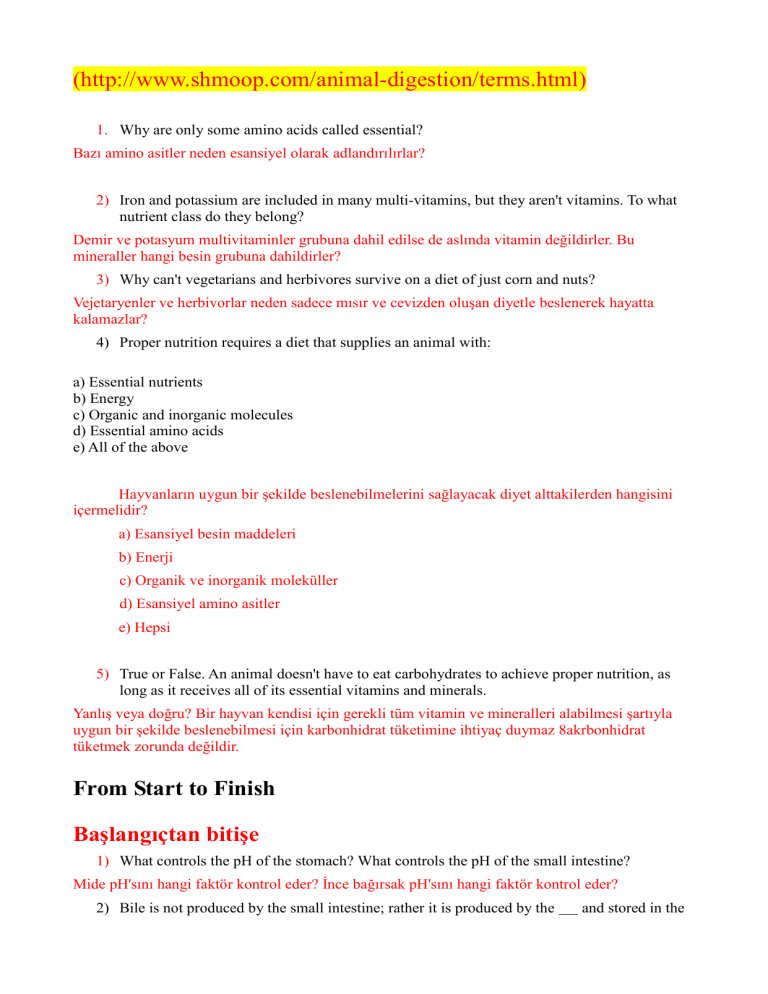
(http://www.shmoop.com/animal-digestion/terms.html) 1. Why are only some amino acids called essential? Bazı amino asitler neden esansiyel olarak adlandırılırlar? 2) Iron and potassium are included in many multi-vitamins, but they aren't vitamins. To what nutrient class do they belong? Demir ve potasyum multivitaminler grubuna dahil edilse de aslında vitamin değildirler. Bu mineraller hangi besin grubuna dahildirler? 3) Why can't vegetarians and herbivores survive on a diet of just corn and nuts? Vejetaryenler ve herbivorlar neden sadece mısır ve cevizden oluşan diyetle beslenerek hayatta kalamazlar? 4) Proper nutrition requires a diet that supplies an animal with: a) Essential nutrients b) Energy c) Organic and inorganic molecules d) Essential amino acids e) All of the above Hayvanların uygun bir şekilde beslenebilmelerini sağlayacak diyet alttakilerden hangisini içermelidir? a) Esansiyel besin maddeleri b) Enerji c) Organik ve inorganik moleküller d) Esansiyel amino asitler e) Hepsi 5) True or False. An animal doesn't have to eat carbohydrates to achieve proper nutrition, as long as it receives all of its essential vitamins and minerals. Yanlış veya doğru? Bir hayvan kendisi için gerekli tüm vitamin ve mineralleri alabilmesi şartıyla uygun bir şekilde beslenebilmesi için karbonhidrat tüketimine ihtiyaç duymaz 8akrbonhidrat tüketmek zorunda değildir. From Start to Finish Başlangıçtan bitişe 1) What controls the pH of the stomach? What controls the pH of the small intestine? Mide pH'sını hangi faktör kontrol eder? İnce bağırsak pH'sını hangi faktör kontrol eder? 2) Bile is not produced by the small intestine; rather it is produced by the and stored in the . a. Pancreas/Gallbladder b. Liver/Gallbladder c. Liver/Pancreas d. Large Intestine/Liver e. Pancreas / Liver Safra ince bağırsaklar tarafından üretilmez; safra ....................... tarafından üretilir ve .....................'de depolanır. a)Pankreas/safra kesesi b) Karaciğer/safra kesesi c)Karaciğer/pankreas d)Kalın bağırsak/karaciğer e)Pankreas/karaciğer 3) What allows the villi and microvilli to absorb a large amount of nutrients? Villi ve mikrovillilerin büyük miktarlarda besin maddelerini abzorbe edebilmelerini hangi faktör sağlar? 4) Where does carbohydrate digestion begin? Where does fat digestion begin? What biological component is responsible for nutrient digestion in these areas? Karbonhidrat sindirimi nerede başlar? Yağ sindirimi nerede başlar? Bu bölgelerde hangi biyolojik bileşen besin madde sindiriminden sorumludur? 5) What is the difference between nutrient active and passive transport into the blood stream? Kan dolaşımında aktif ve pasif besin madde taşınımı (taşınması) arasında ne fark vardır? Osmoregulation Osmoregulasyon 1) Describe water movement in an isosmotic environment. İzoozmotik ortamda su hareketini (taşınma mekanizmasını) açıklayınız. 2) Why do nitrogenous wastes come from the digestion of protein, but not fats or carbohydrates? Azotlu bileşiklerin proteinlerin sindirimi sonucunda ortaya çıkmalarına karşın yağ ve karbonhidratların sindirimi sonucunda ortaya çıkmamalarının sebebi nedir? 3) Through osmosis, water flows from a a. Hyperosmotic / Hypoosmotic b. Isoosmotic / Hypoosmotic c. Hypoosmotic / Hyperosmotic d. Intracellular / Extracellular e. Hypoosmotic / Isoosmotic solution to one that is . Ozmosis sayesinde su ....................çözeltiden...................çözeltiye doğru akar (hareket eder). a. Hiperozmotik/hipoozmotik b. İzoozmotik/hipoozmotik c. Hipoozmotik/hiperozmotik d. İntraselüler/ekstraselüler e. Hipoozmotik/izoozmotik 4) Why won't camels excrete their nitrogenous wastes as ammonium? Develer azotlu artıklarını neden amonyum formunda atmazlar? 5) Use what you know about osmosis to describe how reverse osmosis is used to purify water. Ozmosis hakkındaki bilginiz kullanarak ters ozmosisin suyu saflaştımak amacı ile nasıl kullanılacağını açıklayınız? Water Balance and the Kidney Su Dengesi ve Böbrek 1) How does a longer descending Loop of Henle aid in water conservation? Uzun bir Henle kıvrımı su muhafazasında nasıl katkıda bulunabilmektedir? 2) What are the two critical components to the countercurrent multiplier system? a. NaCl and H+ b. NaCl and urea c. The vasa recta and collecting duct d. The inner medulla and distal tubule e. The descending and ascending Loops of Henle Karşıakım çoğaltıcı sistemin 2 önemli bileşeni hangileridir? a. NaCl and H+ b. NaCl ve üre c. Vaza rekta ve toplama kanalı d. İç medulla ve distal tüpler e. Henle kıvrımları 3) Which is NOT a component in filtrate? a. Small proteins b. Ammonia c. Red blood cells d. Vitamins e. Metabolized drugs Hangisi filtrat içinde almayan bir bileşendir? a. Küçük yapıdaki proteinlerin b. Amonyak c. Kırmızı kan hücreleri d. vitaminler e.Metbolize olan ilaçlar 4) What are the four stages of excretion and where do they occur within the nephron? Boşaltımın 4 aşaması nelerdir ve bu aşamalar nefron içinde hangi bölgede gerçekleşir? 5) As filtrate passes through the proximal tubule, a. Glucose / amino acids b. Red blood cells / H+ c. Ammonia / H+ d. NaCl / water e. Toxins / water and are removed. Filtrat proksimal tüplerde hareket ederken (tüplerden geçerken) ........... ve ............ uzaklaştırılır. a. Glukoz/amino asitler b.Kırmızı kan hücreleri/H+ c.Amonyak/H+ d.NaCl/su e.Toksinler/su 6) How does the structure of the vasa recta assist its function to maintain the inner medulla's high osmolarity? Vaza rekta'nın yapısı iç medullanın yüksek düzeydeki ozmoralitesini sağlamaktaki fonksiyonuna nasıl yardımcı olur? Hormones Hormonlar 1. Cholecystokinin is released by , while causes secretin secretion. a. sugar-containing chyme / acid b. Acid / fatty acid-containing chyme c. Peptide and fatty acid-containing chyme / acid d. Peristalsis / fatty acid-containing chyme e. Secretin / Gastrin Kolesistokinin ...........tarafından açığa çıkartılır, ..................... sekretin salgılanmasına yol açar. a. Şeker içeren kimus/asit b. Asit/yağ asiti içeren kimus c. peptid ve yağ asiti içeren kimus/asit d.Peristalsis/yağ asiti içeren kimus e.Sekretin/gastrin 2. Why is gastrin usually secreted before secretin? Neden gastrin genelde sekretinden önce salgılanır? 3. ADH release is stimulated by , while stimulates ANP release. a. Hyperosmotic blood / low blood volume b. Hypoosmotic blood / low blood pressure c. Hyperosmotic blood / high blood pressure d. Hypoosmotic blood / high blood pressure e. None of the above. ADH salınımı...................tarafından uyarılır, ......................... ANP salınımını uyarır. a. Hiperosmotik kan/düşük kan hacmi b. Hipoozmotik kan/düşük kan basıncı c.Hiperozmotik kan/yüksek kan basıncı d. Hipoozmotik kan/yüksek kan basıncı e. Hiçbirisi 4. Where and how does aldosterone work to increase blood volume? Aldosteron kan hacmini artırmak için nerede ve nasıl çalışır? 5. From where is ANP secreted? What is it secreted in response to? ANP nereden salgılanır? Neye tepki olarak salgılanır? http://www.cram.com/flashcards/physiology-2-for-exam-4-1734028 Where is secretin produced and released? What stimulates its secretion? What are its effects? Sekretin nerede üretilir ve salınır? Sekretin salgılanmasını ne uyarır?? Sekretinin etkileri nelerdir? where is CCK produced and released? What stimulates its secretion? What are its effects? Kolesistekonin (CCK) nerede üretilir ve salınır? Kolesistekonin salgılanmasını ne uyarır?? Kolesistekonin etkileri nelerdir? how do secretion and CCK affect each other? Sekretin ve CCK birbirlerini nasıl etkiler? in non-ruminants, where is the primary site of digestion? Where is the primary site of absorption? Ruminant olmayan hayvanlarda temel sindirim bölgesi neresidir? Temel abzorbsiyon bölgesi neresidir? what are the major functions of the small intestine in ruminants? Ruminantlarda ince bağırsaklarının temel fonksiyonları nelerdir? what are the two anatomical structures of the small intestine most responsible for increasing its surface area? İnce bağırsakların yüzey alanının genişlemesinden sorumlu olan 2 anatomik yapı elemanı nelerdir? what four anatomical features allow very efficient digestion and absorption by the small intestine? İnce bağırsakların etkin sindirimi ve abzorbsiyonunu sağlayan 4 anatomik özelliği nelerdir? what inhibits CCK secretion? CCK salınımını ne engeller? what inhibits secretin secretion? Sekretin salınımını ne engeller? what are the two main "aims" of the digestive phase of small intestinal motility? İnce bağırsak motilitesinin sindirim fazının 2 temel amacı nelerdir? what is the predominate mechanism that the small intestine uses to mix digesta with enzymes? İnce bağırsağın sindirim içeriğini enzimlerle karıştırmak amacıyla kullandığı temel mekanizma nedir? by what two means of controlling motility does the small intestine allow adequate time for digestion and absorption? Hangi 2 motiliteyi kontrol eden faktörle ince bağırsaklar what are the two mechanisms by which the small intestine moves digesta at an appropriate rate? İnce bağırsaklarda sindirim içeriğinin uygun hızda ilerlemelerini sağlayacak 2 mekanizma hangileridir? what is the interdigestive phase of small intestine motility? İnce bağırsak motilitesinin sindirim içi fazı nedir? what is the function of the muscularis mucoase in small intestine motility? İnce bağırsak hareketliliğinde kas yapıdaki mukozanın fonksiyonu nedir? characterize the connection of the ileum to the large intestine İleumun kalın bağırsaklara bağlantısının özelliklerini açıklayınız. what are the two neural controls and function of those controls of small intestinal motility? İnce bağırsak motilitesini kontrol eden 2 nöral kontrol sistemin adını yazarak bu sistemlerin fonksiyonlarını açıklayınız. how does CCK influence small intestinal motility? Secretin? İnce bağırsak motilitesini CCK nasıl etkiler?Sekretin? obstruction of the intestines caused by failure of peristalsis Peristalsis mekanizmasındaki hatadana dolayı ince bağırsakların kasılması (obstruksiyon) what are the two types of diarrhea that occur in the small intestine? İnce bağırsaklarda meydana gelen 2 tip diyare (ishal) hangileridir? what are the four general phases of digestion and absorption in the small intestine? İnce bağırsaklarda gerçekleşen sindirim ve abzorbsiyon işlemlerinin 4 genel fazı hangileridir? what are the main chemical components in the luminal phase of digestion in the small intestine? İnce bağırsaklarda luminal fazın temel kimyasal bileşenleri nelerdir? why is the luminal phase of digestion in the small intestine generally not sufficient to allow absorption of nutrients? İnce bağırsaklarda sindirimin luminal fazı neden genelde besin maddelerinin abzorbsiyonu için yeterli olmamaktadır? in the mucosal phase, what organ produces the enzymes used for digestion, and where are the enzymes located? Mukozal fazda hangi organ sindirim için enzimler üretmekte ve bu enzimler nerede bulunur? what is the maximum size of digesta that can be absorbed by the small intestine? İnce bağırsaklardan abzorbe edilebilecek en yüksek sindirim miktarı nedir? by what two routes can digesta pass from the small intestinal lumen to the basolateral space/interstitium? describe the intracellular phase of digestion in the small intestine. where do nutrients pass in small intestinal absorption after they enter the interstitium? what type of carbohydrate is indigestible by all domestic mammals? where does most digestion of soluble carbohydrates occur in non-ruminants? 6.sayfa

